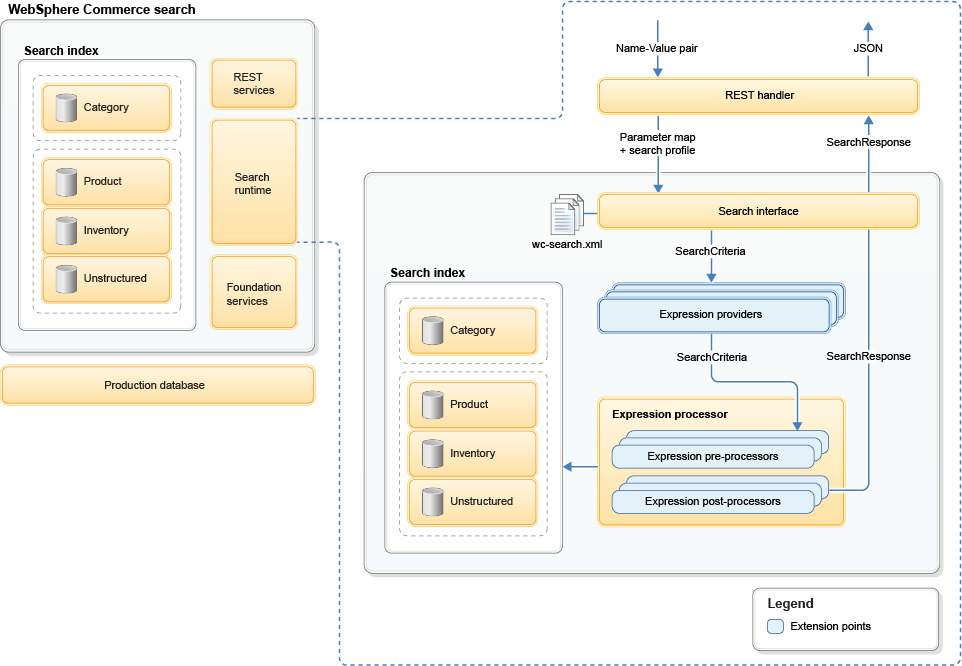WebSphere Commerce Search interactions
Search server architecture
A direct-access path to site navigation and the search server exists on the Solr search server. This server consists of...
- REST services
- Search runtime framework that reuses the current search programming model
- WebSphere Commerce foundation services that also provide access to the WebSphere Commerce database
Search server architecture...
 Where:
Where:
- The REST service mapper is an jersey implementation of JAX-RS 2.0 that uses configurations to map a REST URL to a resource. This resource then calls the embedded search run time.
- The search run time is a pluggable programming framework that allows search expressions to be run by using properties that are defined in a configuration-based search profile. Once a search expression is composed, the runtime then forwards the request to the embedded Solr run time for processing.
- The foundation service is the WebSphere Commerce core run time that can provide basic server services, such as the JDBC Query Service to access the WebSphere Commerce database.
Example
When shoppers enter a search query in the storefront, the query is translated into a REST call. The template used to build the call is in the SearchSetup.jspf file. This template, found in the <wcf:rest/> tag, builds the call as a string.-
<wcf:rest var="catalogNavigationView1" url="${searchHostNamePath}${searchContextPath}/store/${WCParam.storeId}/productview/${restType}">
The
REST call is submitted to the Search server and intercepted by the request handler specified in the call (ProductViewHandler in the above scenario). The request handler checks the wc-rest-resourceconfig.xml file to confirm that the profile being passed is in
the list of search profiles defined for the URI. If the profile is not in the list defined for the URI, an HTTP 400 error will be generated.
If no search profile is specified in the URL (&searchProfile=X), the request
handler uses the first search profile defined in wc-rest-resourceconfig.xml.
For example, for a productview/bySearchTerm request, that profile is
IBM_findProductsBySearchTerm.
If the call is accepted by the request handler, the Search server uses the Jersey implementation
of JAX-RS 2.0 to convert the name-value pairs in the URL into a more usable form via Java
annotation. For example, in the ProductViewResource:
Where the store/{storeId}/productview/{partNumber} URL is mapped to the following method in bold:
The resource then calls the embedded search runtime code, which calls the wc-search.xml file using the search profile names to look up the provider
and preprocessors to call. This method is similar to a factory assembly line, where each business
component can contribute its own piece of the search expression into the main query. After the search run time constructs the final Solr query, it calls Solr and processes the output by using
postprocessors that are defined in the search profile. Then, the REST handler outputs the response.
The search expression is represented by the SearchCriteria Object, which contains a set of
control parameters in the form of name-value parameter maps.
For example, the following snippet from the trace.log file shows that the SearchCriteria is processed by the SolrSearchEDismaxQueryPreProcessor:
After a search expression is composed, the run time forwards the request to the embedded Solr run
time for processing.
If there are any parameters that we want to pass in from the storefront, but do not want to
specify them in the findProductByPartNumber method for example, we can add it to the control
parameter mapper in the wc-component.xml file. This file maps from the name-value pair into the control parameter in the SearchCriteria object.
The search runtime framework is driven by a programming pattern that is similar to a factory
assembly line, where each business component can contribute its own piece of the search expression
into the main query, which is then run against the Solr search engine.
The search runtime programming model uses POJO and raw data that is returned from the search
server to perform simple name-value pair mapping:
A query preprocessor is used to modify the SolrQuery object right before it is sent to the Solr
server for processing.
A query postprocessor is used to modify the QueryResponse object that is returned from the Solr
server.
<GetUri uri="store/{storeId}/productview/bySearchTerm/{searchTerm}"
description="Get products by search term based on below search profile."
searchProfile="IBM_findProductsBySearchTerm,IBM_findProductsByNameOnly,IBM_findProductsByNameAndShortDescriptionOnly,IBM_findProductsByUnstructureOnly,IBM_findProductsBySearchTerm_Summary"/>
@Path("store/{storeId}/productview")
@Description("This class provides RESTful services to get the ProductView details.")
@Encoded
public class ProductViewResource extends AbstractSearchResourceHandler {
@GET
@Path(BY_PART_NUMBER)
@Produces({ APPLICATION_JSON })
@ApiOperation(value = "Gets products by part number.")
@ApiImplicitParams({
@ApiImplicitParam(name = PARAMETER_ASSOCIATION_TYPE, value = PARAMETER_ASSOCIATION_TYPE_DESCRIPTION, required = false, dataType = DATATYPE_STRING, paramType = PARAMETER_TYPE_QUERY),
@ApiImplicitParam(name = PARAMETER_ATTRIBUTE_KEYWORD, value = PARAMETER_ATTRIBUTE_KEYWORD_DESCRIPTION, required = false, dataType = DATATYPE_STRING, paramType = PARAMETER_TYPE_QUERY),
@ApiImplicitParam(name = PARAMETER_CATALOG_ID, value = PARAMETER_CATALOG_ID_DESCRIPTION, required = false, dataType = DATATYPE_STRING, paramType = PARAMETER_TYPE_QUERY),
@ApiImplicitParam(name = PARAMETER_CONTRACT_ID, value = PARAMETER_CONTRACT_ID_DESCRIPTION, required = false, dataType = DATATYPE_STRING, paramType = PARAMETER_TYPE_QUERY),
@ApiImplicitParam(name = PARAMETER_CURRENCY, value = PARAMETER_CURRENCY_DESCRIPTION, required = false, dataType = DATATYPE_STRING, paramType = PARAMETER_TYPE_QUERY),
@ApiImplicitParam(name = PARAMETER_LANG_ID, value = PARAMETER_LANG_ID_DESCRIPTION, required = false, dataType = DATATYPE_STRING, paramType = PARAMETER_TYPE_QUERY),
@ApiImplicitParam(name = PARAMETER_CHECK_ENTITLEMENT, value = PARAMETER_ENTITLEMENT_CHECK_DESCRIPTION, required = false, dataType = DATATYPE_BOOLEAN, paramType = PARAMETER_TYPE_QUERY),
@ApiImplicitParam(name = PARAMETER_ATTACHEMENT_FILTER, value = PARAMETER_ATTACHMENT_FILTER_DESCRIPTION, required = false, dataType = DATATYPE_STRING, paramType = PARAMETER_TYPE_QUERY),
@ApiImplicitParam(name = PARAMETER_PROFILE_NAME, value = PARAMETER_PROFILE_NAME_DESCRIPTION, required = false, dataType = DATATYPE_STRING, paramType = PARAMETER_TYPE_QUERY)})
@ApiResponses(value = {
@ApiResponse(code = 200, message = RESPONSE_200_DESCRIPTION),
@ApiResponse(code = 400, message = RESPONSE_400_DESCRIPTION),
@ApiResponse(code = 401, message = RESPONSE_401_DESCRIPTION),
@ApiResponse(code = 403, message = RESPONSE_403_DESCRIPTION),
@ApiResponse(code = 404, message = RESPONSE_404_DESCRIPTION),
@ApiResponse(code = 500, message = RESPONSE_500_DESCRIPTION) })
public Response findProductByPartNumber(
@ApiParam(value = "The product part number.", required = true) @PathParam(PART_NUMBER) String partNumber) {
SolrSearchEDi > com.ibm.commerce.foundation.internal.server.services.search.query.solr.SolrSearchEDismaxQueryPreProcessor
invoke(SelectionCriteria, Object) ENTRY Search profile: 'IBM_findProductsBySearchTerm', Control parameters:
'_wcf.search.exclude.type=[],' 'DynamicKitReturnPrice=[true],' '_wcf.search.currency=[USD],' '_wcf.search.manufacturer=[],
' '_wcf.search.runAsId=[-1002],' '_wcf.search.contract=[10001],' '_wcf.search.catalog=[10052],''_wcf.search.catalog=[10052],
''_wcf.search.catalog=[10052],' '_wcf.search.internal.response.format=[json],'
Search programming model
 The search run time contains two main components: the search expression provider and the search
expression processor:
The search run time contains two main components: the search expression provider and the search
expression processor: